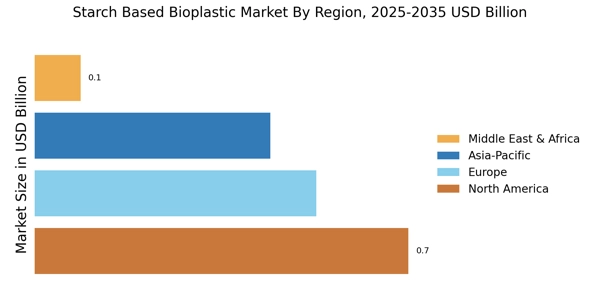Government Initiatives and Policies
Government initiatives and policies play a crucial role in shaping the Starch Based Bioplastic Market. Various countries are implementing regulations aimed at reducing plastic waste and promoting biodegradable alternatives. For instance, several governments have introduced incentives for companies that produce or utilize bioplastics, including tax breaks and grants. These policies not only encourage the adoption of starch-based bioplastics but also create a favorable environment for research and development. The European Union, for example, has set ambitious targets for reducing single-use plastics, which is likely to bolster the demand for starch-based solutions. As these initiatives gain momentum, the Starch Based Bioplastic Market is expected to expand, driven by both regulatory compliance and consumer demand for sustainable products.
Rising Demand for Eco-Friendly Products
The Starch Based Bioplastic Market is experiencing a notable increase in demand for eco-friendly products. Consumers are becoming increasingly aware of environmental issues, leading to a shift towards sustainable alternatives. This trend is reflected in the growing preference for bioplastics derived from renewable resources, such as starch. According to recent data, the market for bioplastics is projected to reach USD 44 billion by 2026, with starch-based options capturing a significant share. This rising demand is driven by both consumer preferences and corporate sustainability goals, as companies seek to reduce their carbon footprints and enhance their brand image. As a result, manufacturers in the Starch Based Bioplastic Market are investing in innovative production methods to meet this demand, potentially leading to a more sustainable future.
Technological Innovations in Production
Technological innovations are significantly influencing the Starch Based Bioplastic Market. Advances in production techniques, such as improved fermentation processes and enzyme technology, are enhancing the efficiency and cost-effectiveness of bioplastic manufacturing. These innovations enable the production of high-quality starch-based bioplastics that meet the performance standards of traditional plastics. For instance, recent developments in extrusion technology have allowed for the creation of bioplastics with enhanced mechanical properties, making them suitable for a wider range of applications. As a result, the market is witnessing an influx of new products that cater to diverse consumer needs. This technological progress not only supports the growth of the Starch Based Bioplastic Market but also positions it as a viable alternative to conventional plastics.
Expanding Applications Across Industries
The Starch Based Bioplastic Market is witnessing an expansion of applications across various sectors, including packaging, agriculture, and consumer goods. The versatility of starch-based bioplastics allows them to be utilized in a wide range of products, from biodegradable packaging materials to agricultural films. This adaptability is attracting interest from manufacturers seeking sustainable alternatives to traditional plastics. For example, the packaging industry is increasingly adopting starch-based solutions due to their biodegradability and compostability, which align with consumer preferences for eco-friendly products. As industries continue to explore the potential of starch-based bioplastics, the market is expected to grow, driven by innovation and the need for sustainable practices.
Increasing Awareness of Environmental Impact
There is a growing awareness of the environmental impact of traditional plastics, which is driving interest in the Starch Based Bioplastic Market. As consumers and businesses alike recognize the detrimental effects of plastic pollution, the demand for biodegradable alternatives is surging. This awareness is further fueled by educational campaigns and media coverage highlighting the benefits of bioplastics. Research indicates that starch-based bioplastics can reduce greenhouse gas emissions by up to 80% compared to conventional plastics. Consequently, companies are increasingly adopting starch-based solutions to align with consumer values and corporate social responsibility goals. This shift not only enhances the reputation of businesses but also contributes to the overall growth of the Starch Based Bioplastic Market.


















Leave a Comment